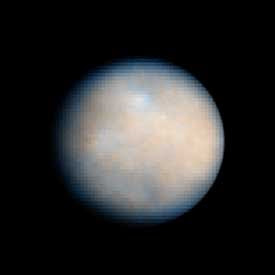M
MeteorWayne
Guest
A relevant piece of new info caused me to dig up the grave: 
Eris Smaller than Pluto?
"The dwarf planet Eris — once thought to be the largest body in the solar system beyond Neptune's orbit — may actually be smaller than Pluto, new observations suggest.
Three teams of astronomers watched through telescopes as the icy Eris passed in front of a distant star over the weekend. The length of the occultation — as the event is called — showed that Eris is likely less than 1,454 miles (2,340 kilometers) wide, the magazine Sky & Telescope reported.
This would make Eris a smidge smaller than Pluto, which is about 1,455 miles (2,342 km) wide....
In an international effort led by Sicardy, dozens of astronomers around the world aimed their telescopes at Eris on Saturday (Nov. 6). Because the dwarf planet is so small and so far away, witnessing the occultation was no sure thing. It would only be visible from certain spots on Earth's surface.
But three teams of astronomers, using different telescopes set up throughout the Chilean Andes, had success. They watched Eris pass in front of a faraway star in the constellation Cetus and timed how long Eris blocked the star's light.
Such information, if recorded at multiple sites, can reveal with great precision how wide a spherical object is. (Astronomers think both Eris and Pluto are spherical). The size calculations made over the weekend may be more reliable than the earlier figures, according to Brown.
"Most of the ways we have of measuring the sizes of objects in the outer solar system are fraught with difficulties," Brown wrote on his blog Sunday (Nov. 7). "But, precisely timed occultations like these have the potential to provide incredibly precise answers."
Rethinking the outer solar system
If the new measurements are accurate, they make a strong case that Eris and Pluto are very different objects.
While the two dwarf planets appear to have very similar surfaces, their interiors are likely quite disparate. Since Eris is apparently much denser, it probably contains more rock and less ice than Pluto, Brown said."
More details in the full story.
Eris Smaller than Pluto?
"The dwarf planet Eris — once thought to be the largest body in the solar system beyond Neptune's orbit — may actually be smaller than Pluto, new observations suggest.
Three teams of astronomers watched through telescopes as the icy Eris passed in front of a distant star over the weekend. The length of the occultation — as the event is called — showed that Eris is likely less than 1,454 miles (2,340 kilometers) wide, the magazine Sky & Telescope reported.
This would make Eris a smidge smaller than Pluto, which is about 1,455 miles (2,342 km) wide....
In an international effort led by Sicardy, dozens of astronomers around the world aimed their telescopes at Eris on Saturday (Nov. 6). Because the dwarf planet is so small and so far away, witnessing the occultation was no sure thing. It would only be visible from certain spots on Earth's surface.
But three teams of astronomers, using different telescopes set up throughout the Chilean Andes, had success. They watched Eris pass in front of a faraway star in the constellation Cetus and timed how long Eris blocked the star's light.
Such information, if recorded at multiple sites, can reveal with great precision how wide a spherical object is. (Astronomers think both Eris and Pluto are spherical). The size calculations made over the weekend may be more reliable than the earlier figures, according to Brown.
"Most of the ways we have of measuring the sizes of objects in the outer solar system are fraught with difficulties," Brown wrote on his blog Sunday (Nov. 7). "But, precisely timed occultations like these have the potential to provide incredibly precise answers."
Rethinking the outer solar system
If the new measurements are accurate, they make a strong case that Eris and Pluto are very different objects.
While the two dwarf planets appear to have very similar surfaces, their interiors are likely quite disparate. Since Eris is apparently much denser, it probably contains more rock and less ice than Pluto, Brown said."
More details in the full story.



